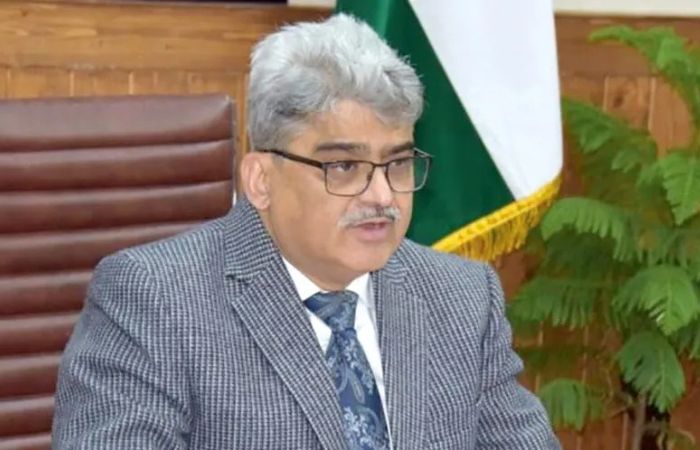By Ishfaq Gulzar (CNI) Correspondent
Srinagar 21 Feb 2025 : Jammu & Kashmir Chief Secretary, Atal Dulloo, chaired a high-level meeting of the Forest, Ecology & Environment Department to assess its functioning and review the progress of ongoing conservation initiatives for lakes and wetlands in the Union Territory.
During the meeting, the Chief Secretary directed officials to formulate a comprehensive action plan based on scientific principles for the rehabilitation of degraded forest areas within a stipulated timeframe. He emphasized the need for an effective forest land management strategy, instructing officials to expedite the survey and demarcation of forest lands by installing boundary pillars and digitizing records to prevent encroachments and protect forest resources.
Focusing on afforestation, Dulloo urged the department to accelerate plantation drives, aiming to plant 1.5 crore saplings by the end of the upcoming plantation season. He underscored the importance of ensuring high survival rates of planted saplings through protective measures such as fencing and proper maintenance.
Highlighting the ecological significance of wetlands, the Chief Secretary stressed the need for rigorous conservation efforts, proper demarcation, and water quality improvement to ensure sustainability. Specific attention was given to Wular Lake, Asia’s largest freshwater lake, where he instructed the Principal Chief Conservator of Forests (PCCF) and the Commissioner Secretary, Forests, to personally inspect the site and devise strategies for accelerating conservation efforts. Recognizing Wular Lake’s tourism potential, he called for urgent and effective conservation measures.
Addressing the conservation of Kishtwar High Altitude National Park, Dulloo highlighted the need for increased manpower and additional resources to achieve tangible results. He noted that the scale of work required surpasses current capabilities, necessitating enhanced efforts for effective environmental management.
The Chief Secretary also emphasized the early approval and implementation of the Biodiversity Action Plan (BAP) in collaboration with other departments. He instructed the formation of an inter-departmental coordination panel to ensure smooth execution of the plan by aligning available funds with designated schemes.
Commissioner Secretary, Forest, Ecology & Environment, Sheetal Nanda, provided an overview of the department’s functioning, outlining key initiatives such as forest conservation, afforestation in urban areas, wildlife sanctuary maintenance, biodiversity conservation, and pollution control efforts. She also highlighted major achievements from the past year and future plans, including the development of the BAP, extensive plantation initiatives, and forest land demarcation.
In his presentation, PCCF Suresh Kumar Gupta revealed that Jammu & Kashmir has approximately 20,194 sq km of forest cover, constituting 47.8% of its geographical area, with a tree cover of 151.8 million trees as per the Draft ToF Report, 2023. He detailed the UT-level BAP framework, aligned with the National Biodiversity Authority’s guidelines, and outlined a strategy covering 11 thematic areas, 38 strategies, and 161 activities, requiring a budget of Rs. 187.8 crore per year up to 2030.
Regarding afforestation efforts, Gupta informed that 81.27 lakh saplings had been planted by January this year, covering 5,703 hectares. He reported that 2,150 sq km of degraded forest land had been identified, with 775 sq km restored in the last five years, while the remaining 1,375 sq km requires Rs. 78 crore annually for the next decade. Additionally, Nagar Van projects have been established in 42 out of 80 urban local bodies, with the remaining areas set for future development.
On forest land demarcation, it was noted that out of 300,853 boundary pillars, 142,144 have been renovated or reinstalled. The survey of the remaining pillars is expected to be completed by December 2025, with the installation process set to conclude by March 2027.
The Chairman of the Pollution Control Committee provided updates on the monitoring of lakes, wetlands, rivers, groundwater, and other water bodies. CEO of Wular Conservation and Management Authority (WUCMA) reported the completion of an 84 km-long Wular Lake boundary demarcation with geo-tagged boundary pillars (1,159 units). Additionally, 11 km of bund consolidation in encroachment-prone areas has been completed, along with dredging of 5 sq km of critically silted sections.
Regarding the environmental management plan for Kishtwar High Altitude National Park, it was revealed that a Wildlife Mitigation Plan worth Rs. 236 crore (including a Rs. 100 crore corpus), a Catchment Area Treatment (CAT) Plan worth Rs. 44 crore, and a Biodiversity Conservation Management Plan worth Rs. 18 crore are in place.
The Department of Wildlife Protection also oversees 10 other wetlands across Jammu & Kashmir, including Hokersar, Shallabugh, Hygam, Mirgund, Chatllalum, Kranchoo, Manibugh, Freshkoori, Surinsar-Mansar, and Gharana wetlands.
The Chief Secretary reaffirmed the government’s commitment to strengthening conservation efforts, protecting biodiversity, and ensuring sustainable management of forest resources across the Union Territory.(CNI)
